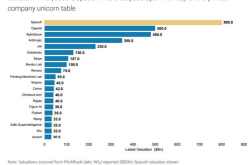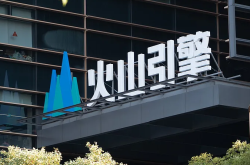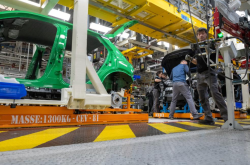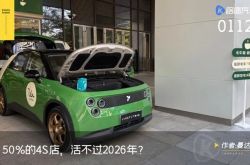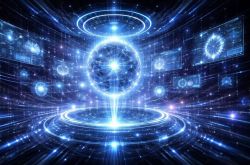Generative AI to Physical AI: The Agent Economy Reshapes the Foundation of "New Infrastructure"
![]() 07/31 2025
07/31 2025
![]() 398
398
Original by IoT Intelligence
This is my 380th column article.
On July 17, at the 3rd Chain Expo, Jen-Hsun Huang, founder and CEO of Nvidia, and Wang Jian, director of the Zhejiang Lab and founder of Alibaba Cloud, engaged in a fireside chat, elaborating on the next wave and industrial goldmine of AI: Physical AI.
Over the past decade, AI technology has evolved rapidly, with paradigm shifts occurring every three to five years. Reviewing the history of AI, we have experienced Perceptual AI, which allowed machines to understand the world; Generative AI, which enabled machines to create content; and Agentic AI, which gave machines preliminary logical decomposition and complex problem-solving capabilities. Today, the global industry and technology giants are focusing on the latest shift: Physical AI.
The essence of this new paradigm is transforming AI from algorithms in the virtual world into super labor in the real world. Unlike the previous three AI waves, Physical AI marks the first time that AI possesses the ability to act. It is no longer just about understanding or generating on screens but directly participating in real-world resource allocation and value creation in physical forms such as robots, autonomous vehicles, and industrial agents.
China is currently in a strategic window period for this global AI competition.
On July 18, the Ministry of Industry and Information Technology (MIIT) issued multiple key policies, including:
1. Accelerating the implementation of the "AI +" initiative to promote the deployment of large models in key industries of the manufacturing sector;
2. Cultivating a group of high-level digital transformation service providers to drive enterprises towards a "product + service" transformation;
3. Organizing and carrying out the "AI + Software" initiative to accelerate the process of software intelligence.
Collectively, these policies aim to make AI not just "talk" but also "work." They not only provide top-level design guidance for the development of Physical AI but also offer practical implementation channels for deploying agents in key industries such as manufacturing, software, and services. Continuous policy reinforcement and collaborative innovation across the industrial chain provide a solid foundation for scenario-based application, standard construction, and ecosystem co-construction of Physical AI.
This article will use this as a starting point to delve into how Physical AI becomes the core engine of China's new-quality productivity and how AIoT agents lead industrial reconstruction.
"Physical AI + AIoT Agents" Become the "New Infrastructure" of the Digital Economy
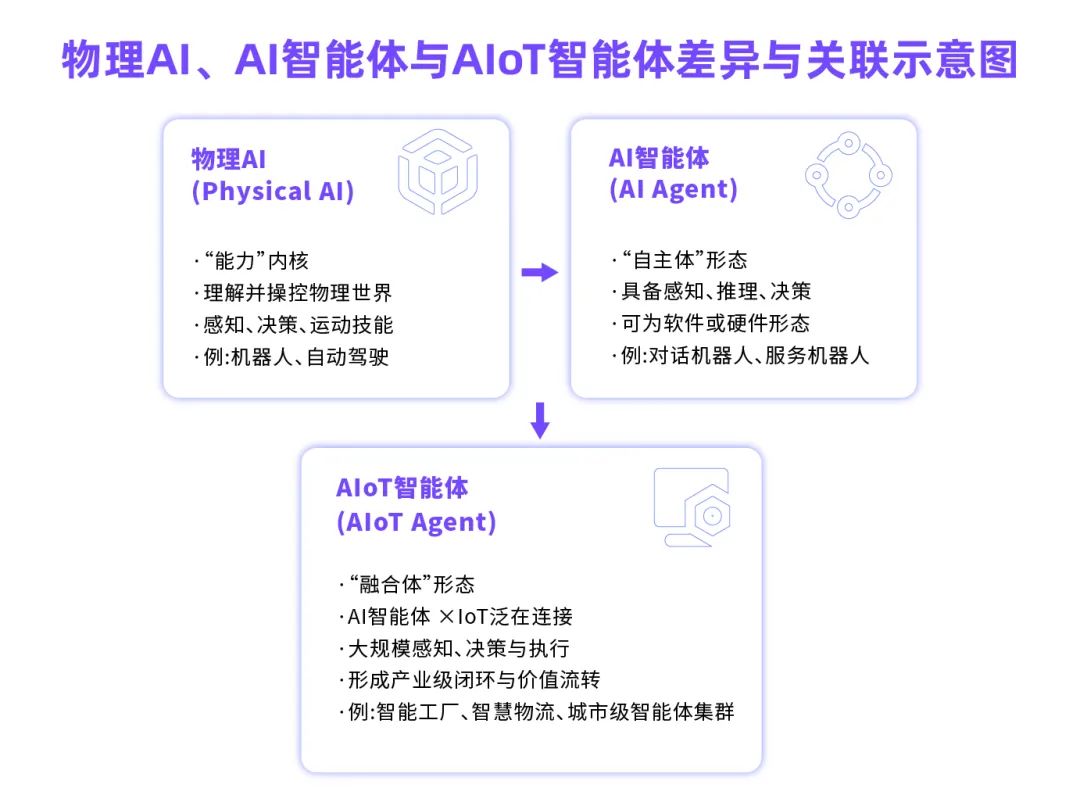
In the latest technological context of AI, we may encounter confusion when facing concepts such as Physical AI, AI agents, and AIoT agents. Clarifying these core concepts is a prerequisite for understanding how AIoT agents become the foundation of new-quality productivity.
Physical AI emphasizes not only letting machines see the world but more importantly, enabling machines to participate physically, possessing full-link capabilities of perception, decision-making, and execution in the real world. The externalization of this capability is embodied in various machine forms, such as robots, autonomous vehicles, and smart equipment, which are all application points of Physical AI's capabilities.
An AI agent, on the other hand, refers to an intelligent system that can autonomously perceive, cognize, reason, and even partially execute tasks. It can be a purely software form such as a chatbot or a combination of hardware and software with physical mobility.
AIoT agents are the product of the deep integration of Physical AI with the ubiquitous connectivity capabilities of the Internet of Things (IoT). This means that AIoT agents not only think in digital space but also work in physical space, efficiently collaborating with thousands of devices and sensors in the environment.
Physical AI represents the "core capability" of AI, AI agents are the software expression of AI capabilities, and AIoT agents are "super agents" that achieve closed-loop and economic value release in large-scale industrial scenarios through the synergy and integration of the two with IoT.
The synergy between Physical AI and AIoT agents can unleash the truest productivity and economic value in large-scale industrial scenarios.
Physical AI endows agents with the soul of "understanding physics and being able to work," while AIoT agents are effective carriers for realizing the large-scale deployment of this soul in complex spaces such as industries, cities, and daily life.
If traditional AI agents mostly stayed at the cognitive level, the breakthrough of AIoT agents lies in their ability to achieve a full-link closed loop of "perception-decision-execution-feedback-economic settlement."
Future industrial competition will eventually shift from virtual wars based on parameter scales to value wars based on agents' closed-loop capabilities. The focus of competition will be on whose agents understand the physical world better, are more capable of action, better at collaboration, and more adept at settlement.
National policies have provided clear guidance on this trend. The MIIT has continuously issued policies on the "AI +" initiative, the deployment of large models in the manufacturing industry, digital transformation, AI + software, etc., emphasizing the need to accelerate the deployment of large models in key industries such as manufacturing.
AI models + the physical world are becoming the foundational infrastructure for China's new-quality productivity and industrial upgrading.
This "new infrastructure" is not only an upgrade of computing power and algorithms but also a paradigm shift in the deep integration of agents with the physical world. Driven by policies, AIoT agents and Physical AI have become key levers for promoting high-quality development of the "AI +" sector.
New Paradigm of "Product + Service" Driven by AIoT Agents
Amid the new wave of digital transformation, many enterprises are facing fundamental restructuring of their service models and productivity structures. Traditional product sales can no longer meet increasingly complex and dynamic market demands, and the deep integration of "product + service" is becoming the core path for the deployment of AIoT agents in industries.
AIoT agents are not just an upgrade of hardware forms but also an intelligent extension of service capabilities. They continuously learn online, perceive the environment, proactively respond to demands, achieve value closed loops, and provide continuous services to customers through platformization and subscription models. The essence of this model is to transform single deliveries into intelligent services, thereby significantly enhancing enterprises' repurchase rates, customer loyalty, and service premiums.
In this trend of industrial upgrading, more and more enterprises are at the forefront of "product + service" innovation. For example, Hainan Huatie recently successfully issued the first batch of 10 million yuan of non-financial Real-World Assets (RWA) based on blockchain, which is a typical representative. 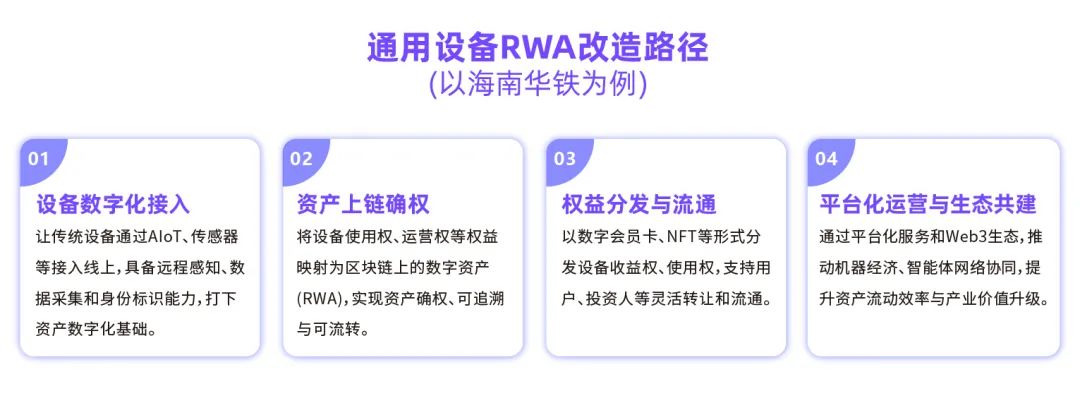
Hainan Huatie's non-financial RWA project not only pioneers the path of traditional equipment leasing + Web3 asset digitization but also provides an explorable real-world sample for the platform service + machine economy model driven by AIoT agents. The company has currently accumulated 26 billion yuan of assets on the blockchain, and the comprehensive operational services of equipment are gradually becoming online, asset-light, and platform-based. This case fully opens up the imagination of how AIoT agents, digital assets, open-source innovation, and industrial collaboration can promote comprehensive upgrades in enterprise services, asset operations, and industrial ecosystems under the guidance of national policies.
The financial curve of traditional manufacturing assets is typically front-loaded and back-tailed: a heavy CAPEX for machine equipment procurement is first recorded on the balance sheet, followed by slow value release through depreciation over the next five to ten years.
The machine economy flips this curve: after embedding models, edge wallets, and on-chain settlement logic into the same equipment, it turns into intelligent labor priced by the minute, process, or even result. Enterprises no longer need to purchase equipment in one lump sum but instead list OPEX directly on the income statement based on usage duration or output.
Cash flow changes accordingly:
First, the initial capital occupation of manufacturing enterprises drops sharply, and the equipment onboarding cycle is shortened from "contract negotiation → order placement → waiting for delivery" to "contract signing → wallet activation → immediate use," releasing funds for R&D or market expansion.
Second, the revenue of equipment suppliers shifts from single-transaction sales to continuous cash flow, significantly shortening the aging of accounts receivable; second-level collections in stablecoins reduce accounts receivable to nearly zero, and asset turnover rates increase significantly.
Third, the valuation logic of the capital market for these two types of entities synchronizes: manufacturing enterprises enjoy higher ROIC due to lighter assets and more stable cash flow, while equipment suppliers benefit from SaaS premium due to predictable recurring revenue.
CAPEX is sliced into fine-grained OPEX, and machines evolve from fixed assets into programmable, priceable, and financialized productivity nodes—this is the financial imagination space opened up by Physical AI.
Therefore, in the era of the AIoT agent economy, an enterprise's core competitiveness is no longer just the number of devices it owns but rather its ability to build an agent network oriented towards industries and scenarios and self-evolving service capabilities.
This requires enterprises to conduct systematic upgrades from the underlying architecture to the operating model.
The construction of a standard system and the prosperity of an open and open-source ecosystem become key supports for the large-scale deployment of agents and industry collaboration. Standards not only ensure interconnection and secure collaboration between different vendors and platforms but also provide a foundation for the reusability, migratability, and sustainable innovation of AIoT agents.
On the other hand, the open-source ecosystem is also indispensable. Open source accelerates the rapid iteration and large-scale promotion of foundational innovations such as AI algorithms, agent operating systems, and industry application platforms, enabling all parties in the industry to share technological dividends with low thresholds and jointly build an agent industrial ecosystem.
Advancing Manufacturing and Services: Local Breakthroughs and Global Leadership in China's AIoT

As a global manufacturing powerhouse, China is undergoing an unprecedented industrial leap. Over the past few decades, China has achieved a historic leap from a world factory to smart manufacturing and services by leveraging its vast industrial chain system and engineering capabilities. However, to further enhance our global competitiveness in the future, we must transform from a manufacturing powerhouse to a service powerhouse, achieving a fundamental upgrade from "manufacturing capabilities" to "manufacturing service capabilities."
The key to this transformation lies in how to convert China's advantages in engineering capabilities, industrial organization, and large-scale deployment in the physical world into service output capabilities driven by agents. AI will play an irreplaceable core role in this transformation process.
First, AI and AIoT agents serve as bridges connecting manufacturing and services. They enable traditional manufacturing resources and engineering equipment to transform from "passive assets" into "industrial agents" that can perceive in real-time, intelligently schedule, and autonomously serve.
For example, an equipment manufacturing enterprise can transform originally saleable industrial equipment into a new business model of equipment-as-a-service through AIoT agents, enabling remote monitoring, predictive maintenance, intelligent leasing, and asset management on a global scale.
This means that the value of manufacturing enterprises is no longer reflected in the number of devices sold but in providing continuous, intelligent, and personalized product + service solutions to global customers, achieving a shift from product output to capability output.
This transformation process involves several key steps, as shown in the figure above. China possesses the world's richest industrial scenarios, the largest group of engineers, and the most resilient innovation ecosystem, providing unique advantages for the large-scale deployment and ecosystem co-construction of AIoT agents. By formulating open technical standards, promoting open-source collaboration, and building industry-level agent platforms, we have the capability to precipitate our locally accumulated experience into globally referable industry foundational standards and ecosystem templates.
Closing Remarks
With the development wave of Physical AI and AIoT agents, China is standing at a critical juncture of a new round of industrial transformation. This article has combed through the rise of the new "product + service" ecosystem, practical explorations by enterprises in the fields of agent innovation and digital assets such as RWA, and the systematic path for the transformation from manufacturing to services. It is evident that AIoT agents are not only the core engine for accelerating the evolution from "manufacturing" to "manufacturing services" but also have the potential to drive China's key industries to achieve a leap from scale advantages to capability output and from local innovation to global paradigms.
Grasping the strategic window of the AIoT agent economy is both a growth opportunity for China's new-quality productivity and a necessary path for reshaping the global industrial landscape.
References:
1. Jen-Hsun Huang Unveils the New Era of AI: The Rise of Physical AI and Its Significance. Source: Eastmoney.com
2. Insightful Conversation: Transcript of Wang Jian's Dialogue with Jen-Hsun Huang on July 17, 2025. Source: Datawhale
3. Milestone Achievement: Hainan Huatie Launches First Batch of 10 Million Yuan Non-Financial RWA Products. Source: Hainan Huatie

